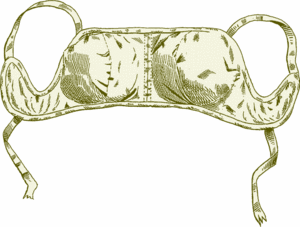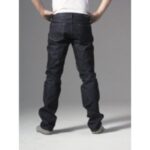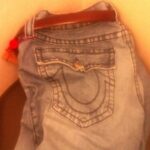Undergarments. Inner fashions. Body fashions. Innerwear. These are all alternate names for intimate apparel—the clothes worn under outer garments, like jeans and sweaters. Intimate apparel can serve both practical and erotic purposes. Practically speaking, intimate apparel limits direct contact between the skin and outer garments, meaning that perspiration is less likely to discolor or damage the outer garments and the skin is protected from the outerwear (Stone 310). There are three basic categories of intimate apparel: innerwear, bodywear, and legwear, all three of which will be discussed to some extent in this paper.
An Annotated History: Intimate Apparel in the 20th Century
During the Victorian Age (1837-1901), intimate apparel, especially for women, was much more complicated and therefore cumbersome to wear than it is today. Women tried to conform to the hourglass figure, which emphasized a full bust and full hips with a tiny waist. Popular intimate apparel of the era included whalebone corsets, bustles, bodices, and bloomers (Stone 10)—none of which are conventionally worn today outside of costumed or erotic occasions. Men’s intimate apparel was far less extreme and hardly differs from today’s: some type of under shirt, pair of boxers, and smart socks.
While clothes relaxed during the Edwardian Era (1901-1910) with the introduction of bloomers and gradual acceptance of bras, it was not until the 1920s that Western women began openly rejecting constricting intimate apparel. Chest-flattening bras, adopted to emphasize a boyish figure, came into fashion (Stone 14). The 1930s, which encompassed the Great Depression, saw more relaxed clothing (Stone 16) than those of the ornate Roaring Twenties, meaning that intimate apparel became less structured, as well. During 1940s, the onslaught of WWII demanded war rationings for military purposes so women often had to forgo luxuries like silk stockings. In the 1950s, women began embracing their feminine figures again but not to the harsh extreme of the Victorian age. Corsets, for example, regained popularity but they were much less restrictive than the ones created in the 1800s. In the 1960s, women’s intimate apparel continued to appear feminine until the end of the decade when the hippie era begin. At that point in history, many women deemed bra a product of the patriarchy and refused to wear them; women protesters even publicly burned their bras as part of the social revolution that went on into the 1970s (Stone 312).
The 1980s represented the decade of excess, meaning that even intimate apparel—garments that nobody publicly saw—suddenly became a status symbol. Coveted brands like Calvin Klein enjoyed huge success because Americans wanted to prove to their peers that they could afford expensive clothes and accessories. The 1990s, by contrast, were much simpler. Name brands began to lose some of their appeal, especially when grunge culture, which shunned materialism, came about. Shopping for intimate apparel and other clothes at discount “big box retailers” became the norm, not a thing of shame.
Definitions and Current and Future Trends
Over the past several years, the line between intimate apparel and garments meant for everyday, public occasions has blurred. Today it is not uncommon, for instance, to see a woman sport a lacy camisole under her jean jacket or a man walking around in a plain thermal top.In the Fall 2008 season, lace is all over trendy women’s boutiques and department stores alike; earlier this year, Prada showcased lace for its Fall 2008 collection. Shoppers will find lace on a wide variety of items, ranging from panties to bra to hosiery. Other trends that span across all types of intimate apparel are Gothic details (plaid, skulls, etc.) and the colors purple (often an eggplant shade or bright violet) and pale gray. Retro style undergarments with modern improvements, like 1940s garters and stockings, are also Fall 2008 must-haves.
For winter and spring 2009, the following trends will pervade women’s clothing: cool blues, berry tones, varying shades of gray, graphics, Goth, interesting layering, flowing separates. For men, shades of gray and earth tones accented by splashes of white, very lightweight fabrics, and frogman leggings will all be in style. Television and movie characters will continue to theme children’s underwear.
The following paragraphs provide basic definitions and information about typical forms of intimate apparel as well as report trends for Fall 2008 and 2009 that have not already been mentioned.
Bra. The modern women is much more concerned about personal comfort than her Victorian sisters. While women may still suffer for fashion, bra has replaced the corset. There are multiple types of bra, ranging from push-up to padded to demi to strapless to T-shirt to sports. Specially-designed bra exist for pregnant and nursing mothers, as well as very full-figured women. Sizing for bras ranges from an A cup to a HH cup in extreme cases. Bras, overall, are very stylish right now. Society encourages the modern woman to find a comfortable bra that makes her feel sexy. Lacy push-up bras, like the ones exhibited by Victoria’s Secret models are especially stylish in Fall 2008. Training bra, smaller, less supportive bra for girls just beginning puberty, are popular in the children’s department. Even little girls who have not started to develop yet will wear cut-off camisoles because the concept of “growing up” (or, more precisely, becoming a teenager) is widely celebrated.
Camisoles. Many women layer these thin, sleeveless tops over their bra to provide extra coverage but camisoles are also commonly worn plain in the summertime. See-through and sheer fabrics will come into style in 2009, as well cropped camisoles that expose the midriff.
Undershirts. Both men and women either wear thin T-shirts or tank tops in cotton or cotton-polyester mixes. Tees and tanks generally have round or V-necks. People wear undershirts beneath their outer shirt for extra coverage and warmth; others use them as pajama pants.
Lower Body
Hosiery. Hosiery includes anything type of knitted cloth-based foot and legwear. Stockings, thigh-highs, pantyhose, leggings, tights, and socks all examples of hosiery. In Fall 2008, trends include fishnet pantyhose and patterned tights (mainly in plaid, animal prints, and Gothic motifs.)
Panties. Women have several different options for panties in this day and age. Bikini cut, classic briefs, boy shorts, full briefs, hi-cut panties, thongs, low-rise panties, and tummy control panties are all examples of the cuts a woman can choose. Her interest in the latest trends, her desire for comfort, and her views about the (un)importance of modesty will all likely influence which cut she selects. Skimpier panties, such as thongs, carry sexual connotations that high-cut panties—often nicknamed “granny panties” in popular culture—do not. Therefore, the more religiously or morally conservative a woman is, the less likely it is that she will deem thongs appropriate for her beliefs and lifestyle. Panties come in every color imaginable, from neutrals to pastels to fluorescent shades, and also come in a span of fabrics including cotton, polyester, satin, leather, nylon, mesh, latex, and lycra. Feminine, retro-style underwear and sporty underwear with come-hither or sarcastic messages written on them are currently stylish. Of the moment panties for little girls’ feature television and movie characters.
Shaping underwear. Shaping underwear serve to smooth out a woman’s silhouette and make her appear slimmer and better toned than she actually is. Certain materials, such as lycra and spandex, simply fit better against another smooth fabric, such as the kind used for shaping underwear, than they do against human skin. Certain shaping underwear actually enhance an area, such as the derriere, and make it appear shapelier and comelier than it naturally is. Most of women’s shaping underwear looks more or less like regular panties, bicycle shorts, or cropped leggings. Supportive slip dresses exist to a lesser extent. A limited selection of shaping underwear is also available for men, such as tops that flatten the gut, but are less common. Shaping underwear overall is very popular in this age of self-improvement, with Spanx as the most commonly known brand.
Men’s underwear. Boxers, briefs, and boxer briefs are the three main types of men’s underwear. Boxers are more or less under shorts with a slit up for the front to make using the restroom more convenient. Briefs have the same basic shape as women’s panties but the crotch is larger and more accommodating. Boxer briefs are exactly what they sound like: a hybrid between boxers and briefs. Plaid boxers, which are typically regarded as a classic, a very stylish in Fall 2008. Boxers are not usually subject to many changing trends but, in 2009, they should contain more graphic designs.
Whole body
Long underwear. Long underwear, also known as Long Johns and thermal underwear, are specially designed to keep the body warm in cold weather. In certain climates, it is necessary to wear long underwear year-round while in others, only during the winter or perhaps not at all. Pattered long underwear, especially with Gothic themes for women and plaid/rock n’ roll themes for men, are stylish in Fall 2008. For children, thermals with their favorite television and movie characters are popular. Generally speaking, however, thermals are subject to very little change from season to season.
Retailers and Manufacturers
Hanesbrand Inc. A global consumer company based in Winston-Salem, North Carolina, Hanesbrand Inc. has existed for over a century and caters to the budget market. In the category of intimate apparel, the company manufactures everything from panties to men’s underwear to children’s underwear to socks to T-shirts to bras and more. Outside of intimate apparel, the company also manufactures casual wear and active wear. Their brands include Bali, Champion, Hanes Hosiery, Playtex, Wonderbra, Hanes, Hanes Her Way, DIM, L’eggs, Champion Products, Champion Woman, Champion Jogbra, Hanes Resilience, and Hanes Silk Reflections. Their target market is the All American man, woman, or child seeking relaxed basics at stores like K-Mart, Wal-Mart, Kohl’s, JC Penney, and Target. A six-pack of women’s panties costs $8, camisoles range from $7 to $14, and a three-pack of men’s boxers costs $9 (Hanes 2008). Their main competition is Fruit of the Loom, Inc. and in-house discount retailer brands, such as Basic Wear by Wal-Mart.
Victoria’s Secret. They sell lingerie and, more recently, lounge and sportswear, like tracksuits and tote bags. Outside of clothes, they sell beauty supplies, shoes, and gifts. Part of the “better” market, Victoria’s Secret’s average bras range from about $30 to 50 while thong panties are usually $5 or $6 a piece and camisoles range from $20 to 30 (Victoria’s Secret 2008). Victoria’s Secret’s target market is the stylish, often younger, woman who wants to embrace her sexy, feminine side. Online boutiques, like Lover’s Lane, compete with Victoria’s Secret for the same customers: young women (and men shopping for women) with a desire for something sensuous and glamorous. Urban Outfitters offers a different atmosphere and style of intimate apparel (more vintage-inspired) than Victoria’s Secret but they both target fashionable young women in the better market.
Carole Hochman Designs. Since 1930, Carole Hochman Designs has produced high fashion women’s sleepwear, loungewear and daywear. Brands include Carole Hochman, Lilly’s Fashion, Oscar De La Renta Lingerie, Sara Beth, Christian Dior, On Gassamer, Christian Dior Intimate Apparel, Betsey Johnson Intimates, D’lish By Daniella Simon, and Luxury Liner By Ongossamer. One pair of Betsey Johnson panties costs $18; a Betsey Johnson slip costs about $60 to $80 (Betsey Johnson 2008). A Carole Hochman women’s sleep shirt costs over $60 while robes are about $80 (Carole Hochman 2008). Their main competitors include other high-end design groups and custom lingerie tailors.
Closing
While the styles, colors, and designs of intimate apparel have widely fluctuated over the past century, their basic purpose remains the same: to protect the skin and outerwear, and, in more generous times, actually feel comfortable.
Works Cited and Bibliography
Betsey Johnson. Betsey Johnson clothing/online catalog. Retrieved October 2, 2008, from Betsey Johnson website: http://www.betseyjohnson.com
Carol Hochman Designs. Carol Hochman sleepwear/online catalog. Retrieved October 1, 2008 from Carol Hochman website: http://www.carolehochman.com/robes_c_15.html
Fashion Trendsetter. The Online Fashion Forecasting e-Zine. Retrieved October 1, 2008 from Fashion Trendsetter e-zine: http://www.fashiontrendsetter.com/content/color_trends.html
Hanesbrandinc. Hanes menswear and womenswear. Retrieved October 1, 2008, from Hanes website: http://www.hanes.com
Stone, Elaine. The Dynamics of Fashion, Third Edition. New York: Fairchild Books, Inc., 2008.
Victoria’s Secret. Victoria’s Secret bras and panties/online catalog. Retrieved October 2, 2008, from Victoria’s Secret website: http://www.victoriassecret.com





